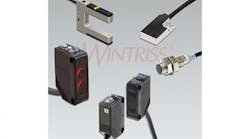W4F Miniature Proximity Sensors
W4F miniature photoelectric sensors use ASIC technology from SICK to consistently deliver reliable detection results. These sensors can detect jet black, highly reflective, flat or transparent objects while also providing distance information, such as the height of objects and identify process errors.
The Blue Pilot operating concept combined with the monitoring options make configuring and monitoring the sensors easier which saves time during commissioning. IO-Link and smart functions create the link to the digitalized machine and application world. The W4F provides maximum performance in the smallest installation space, reliable switching behavior, and a guaranteed process setup, even in the new applications that open up for the W4F. Its rugged Vistal plastic housing offers sensor functions and performance characteristics that were previously only available in the larger W16 and W26 product families. The latest generation of miniature photoelectric sensors offers the same look and feel.
The sensors accomplish up to a 47% greater working distance than the preceding product family and a 38% less black/white shift between the object and background. This also applies to the improved active detection of sources for optical interference in the vicinity of the machine environment, and the suppression of this interference. The high level of immunity to interference is achieved thanks to the integration of an additional diffuse LED which is a first for this type of sensor. The background suppression of the W4F guarantees a continuous machine operation with no interference from the surroundings.
The foundation for this performance is the development of a new ASIC that enables both the two light-intensive pin-point emitter LEDs and the diffuse LED to be operated concurrently without any appreciable heating of the sensor. This avoids the risk of a temperature-related failure. The ASIC also directly digitizes the photocurrents of the reflected light at each pixel of the multipixel receiver. This enables the sensor to achieve not only very high sensitivity but also a long sensing range and reliable detection behavior even for poorly reflecting object surfaces.
The W4F portfolio comprises two sensor business fields: Optical Standard and Optical Experts. The sensors in the Optical Standard business field are ideal for space-saving and high-performance tasks for object detection. The sensors are a through-beam photoelectric sensor and a photoelectric retro-reflective sensor, each with a long sensing range as well as two photoelectric proximity sensors with background suppression.
For especially challenging situations, users can use the Optical Experts which are designed for specific applications. With the help of its laser-like light spot, its V-optics, and its specially tailored optics design, the V-Optics variant can reliably detect even the most reflective or transparent objects such as wafers or displays.





